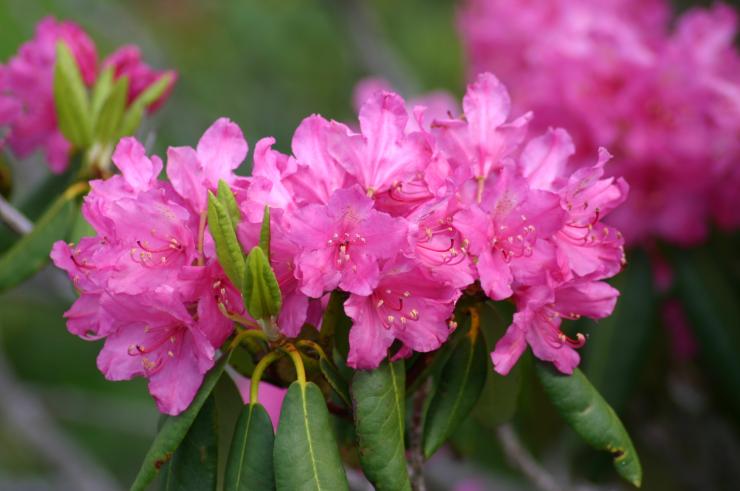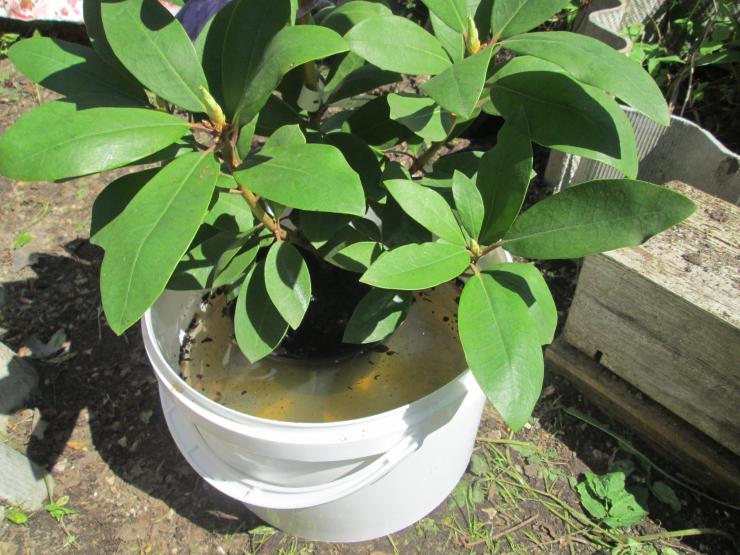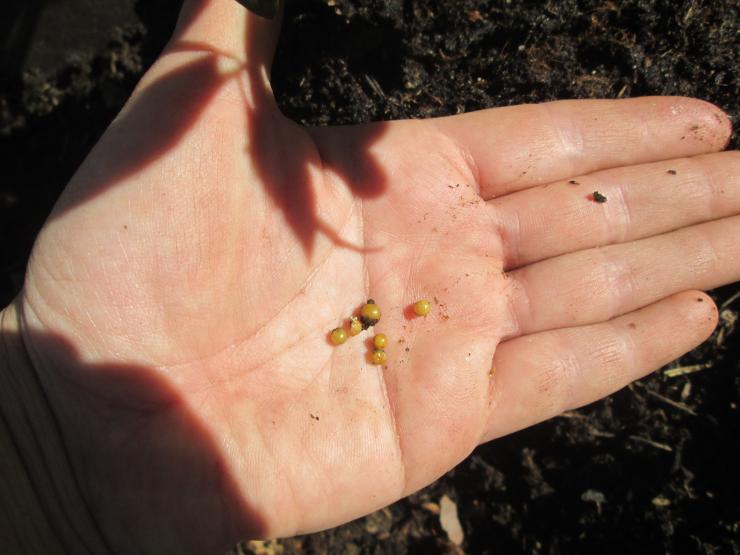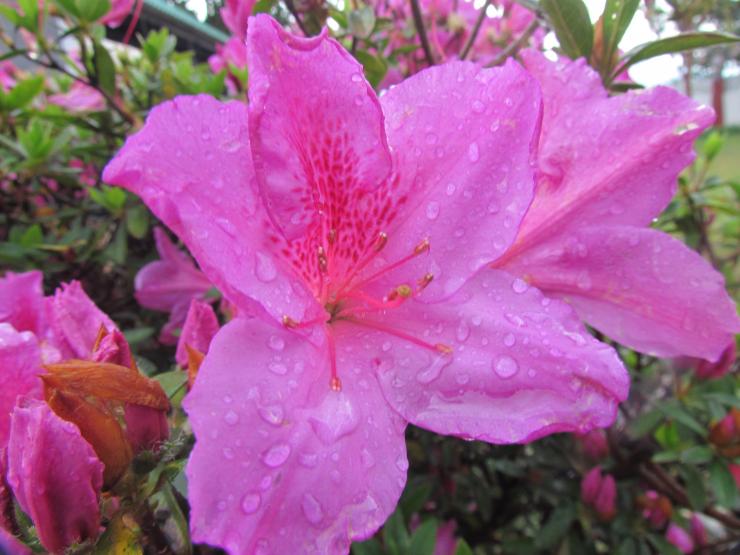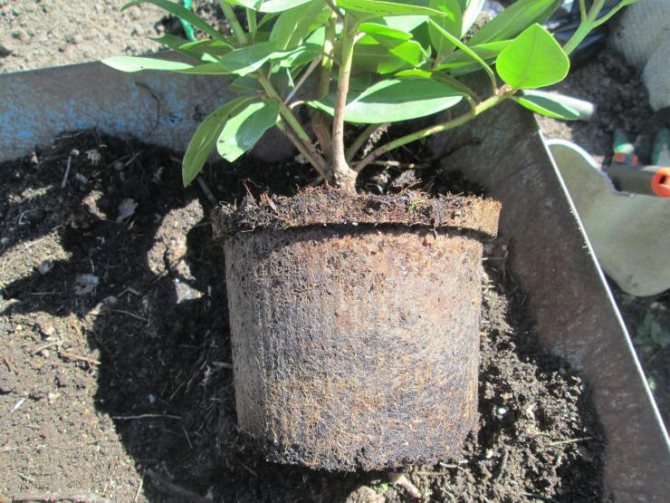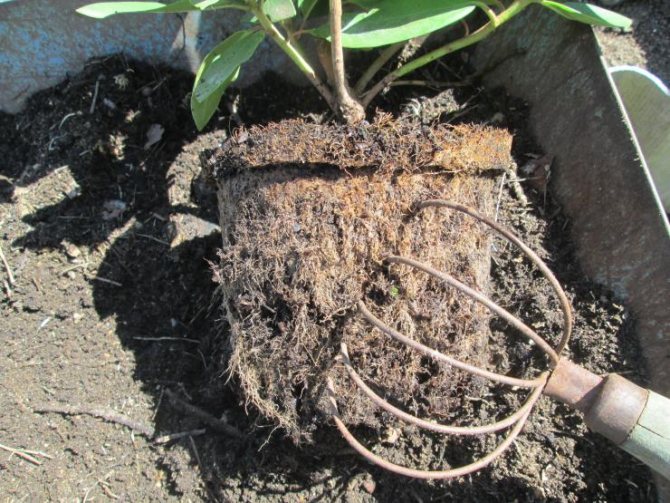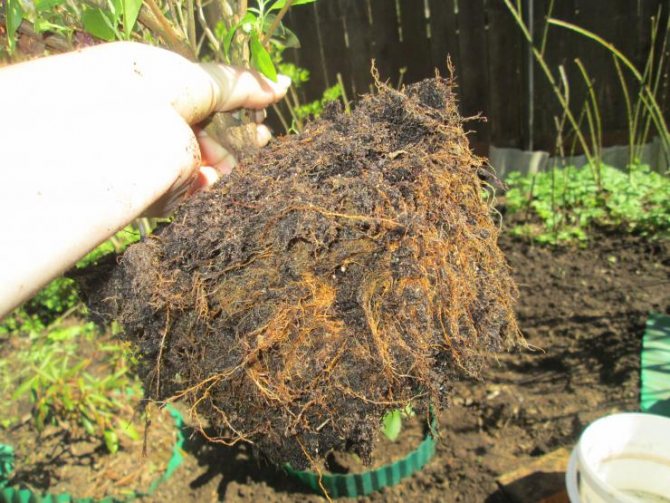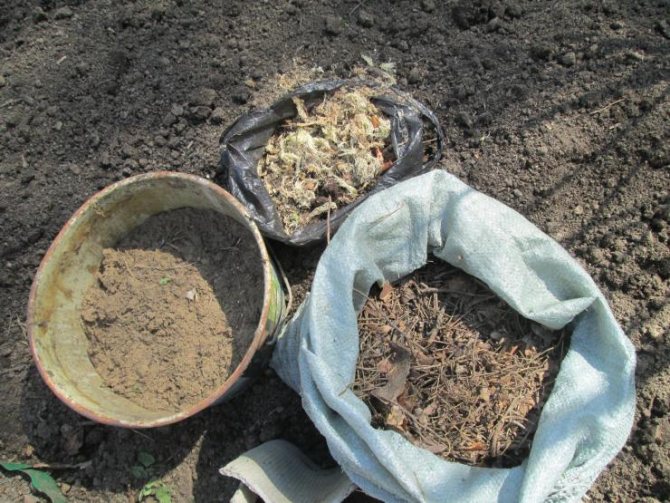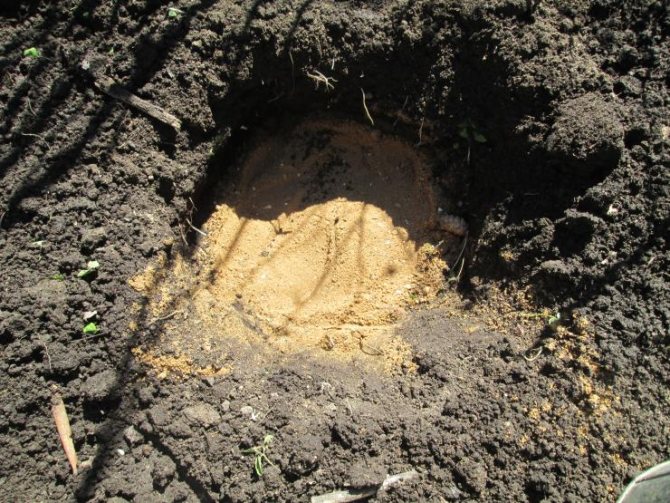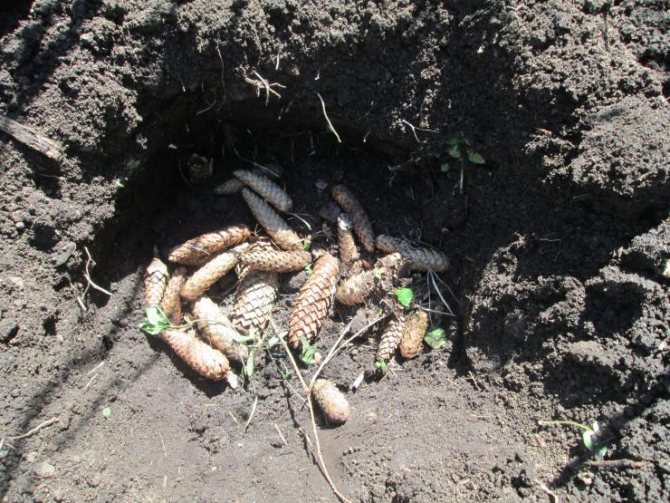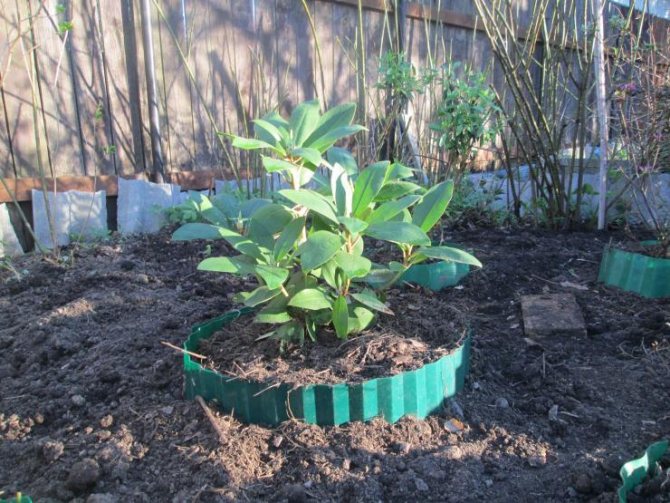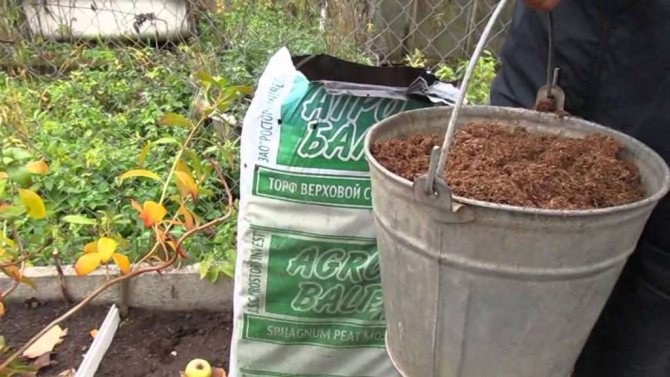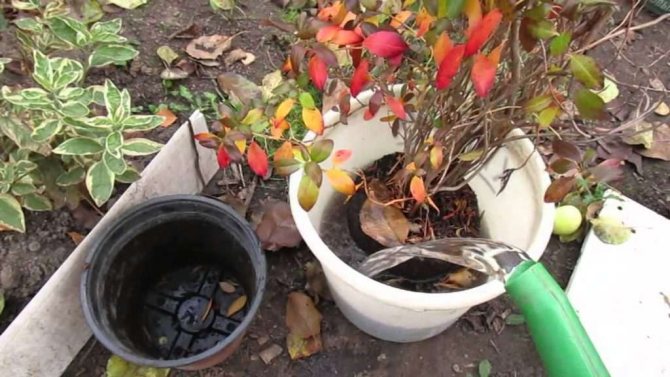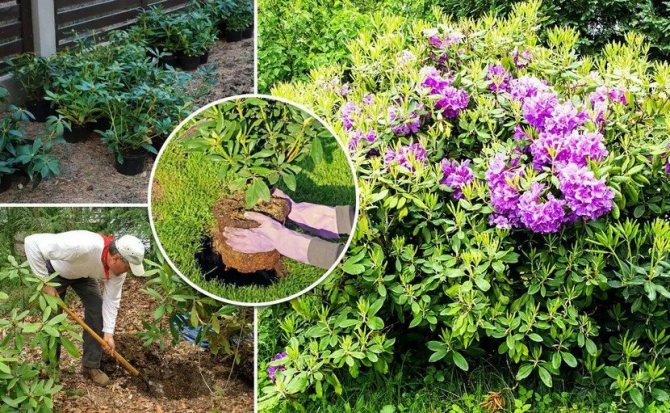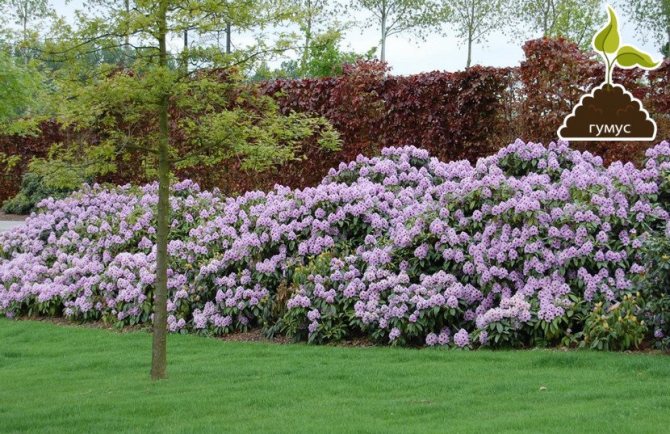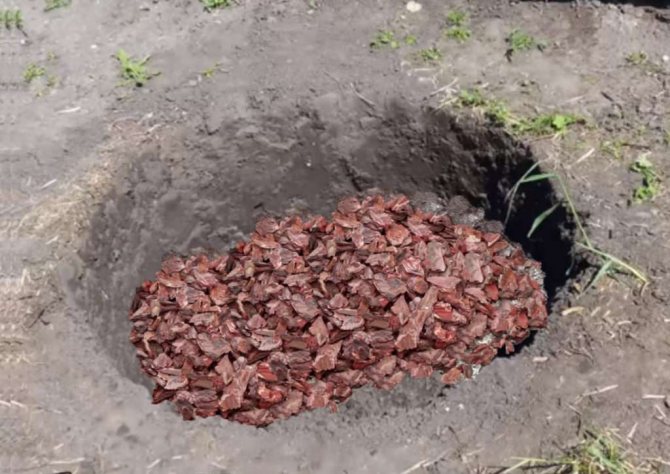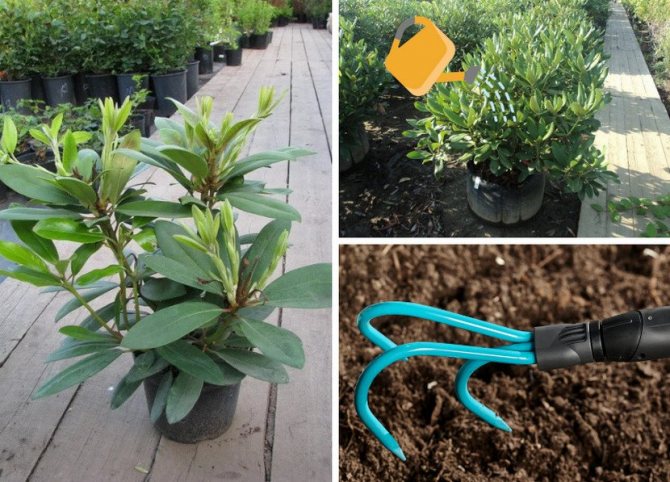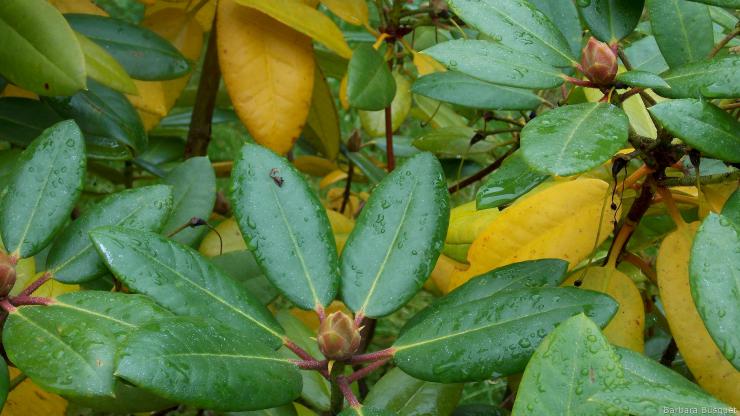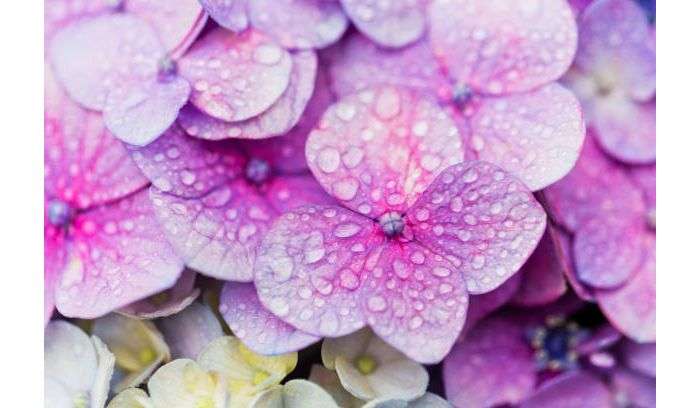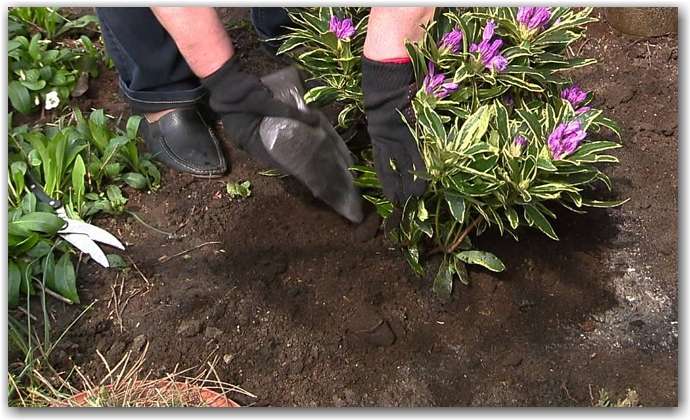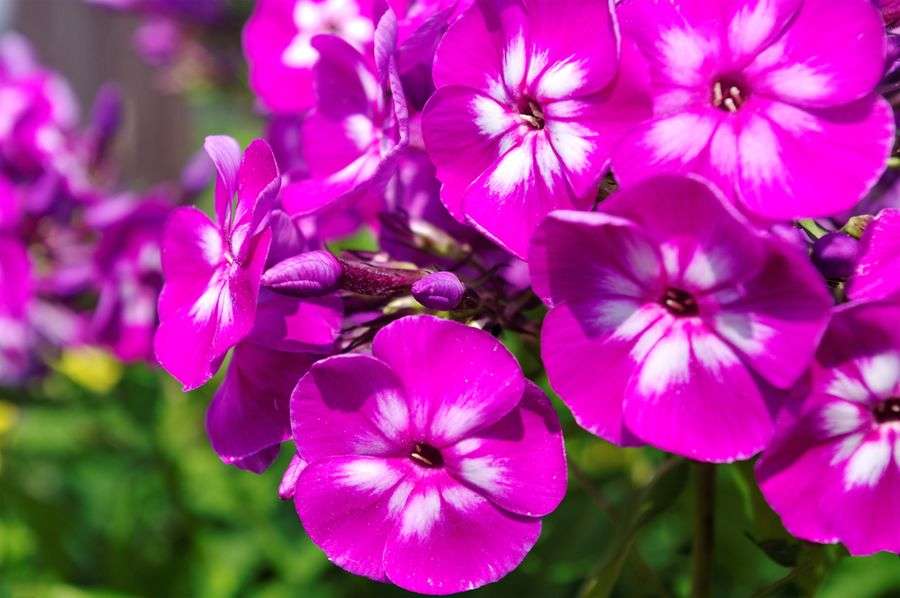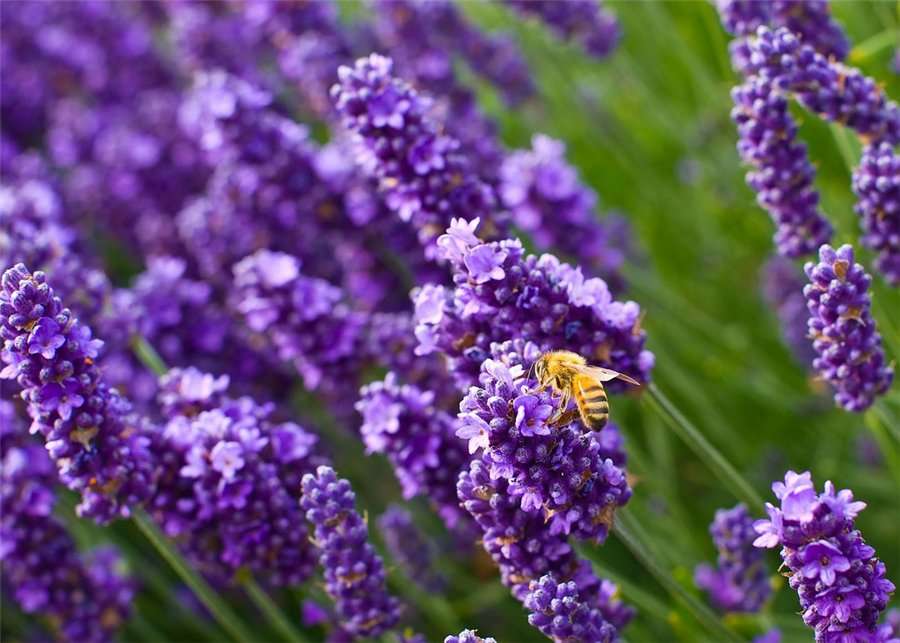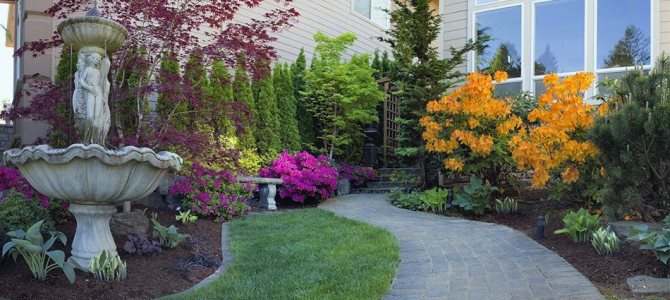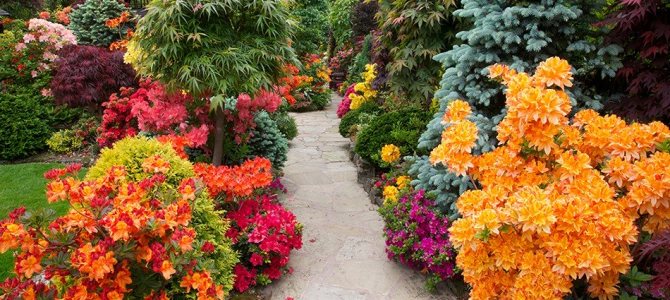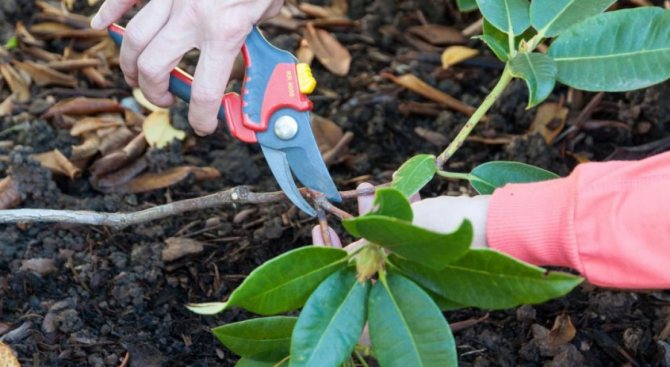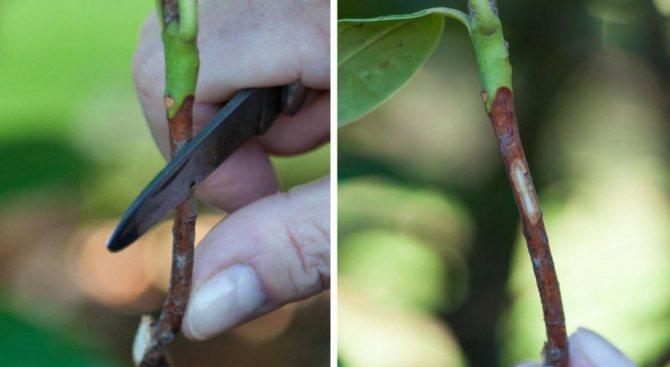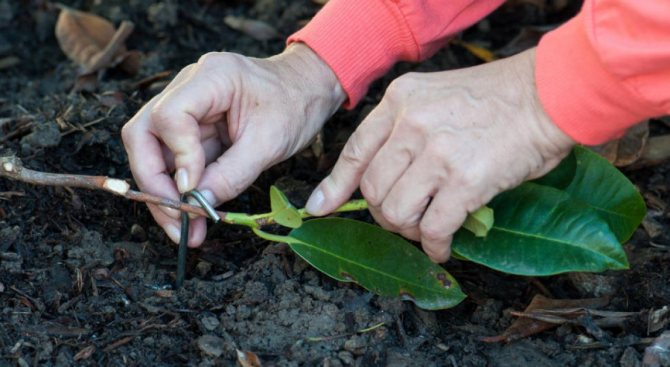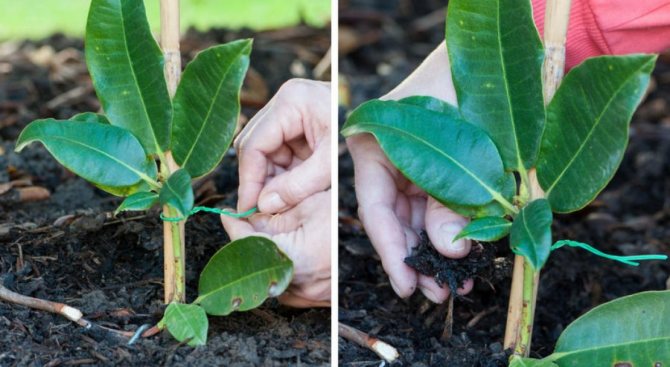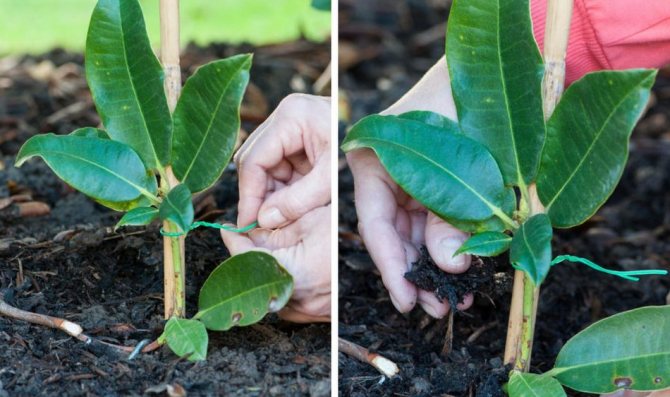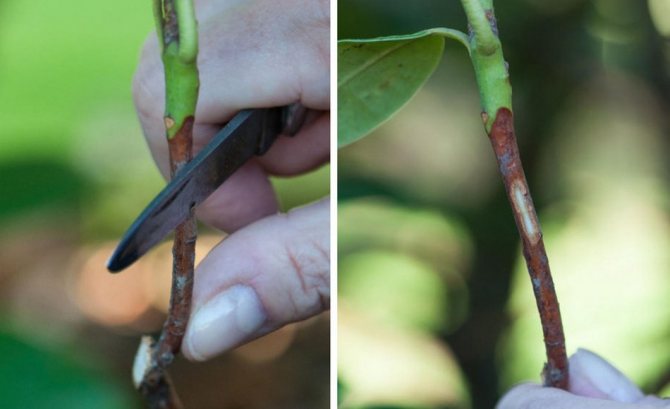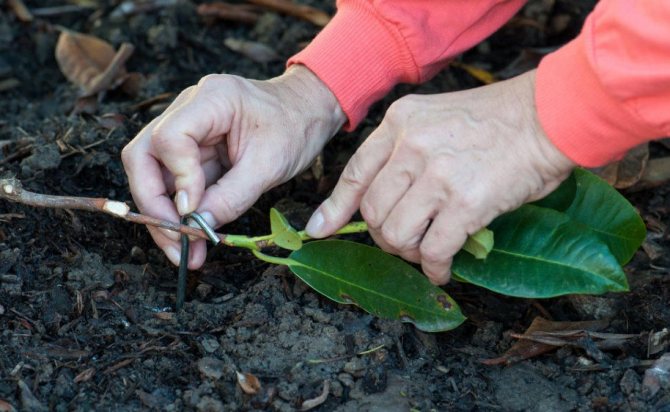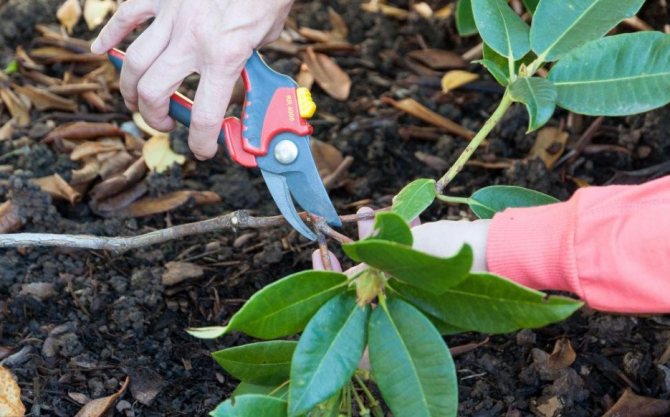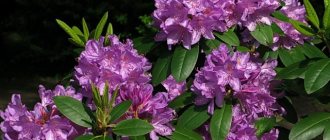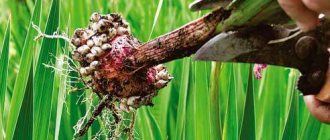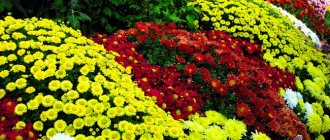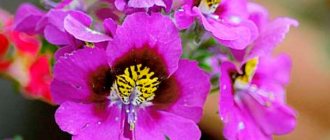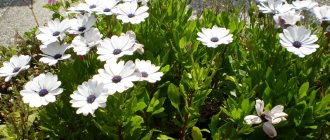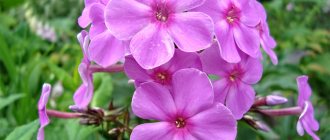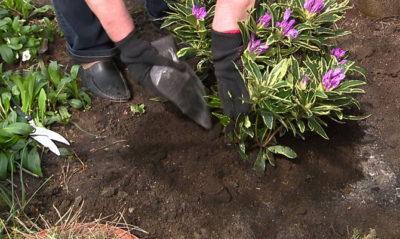
Rhododendrons are evergreen shrubs or small trees. These are unusually beautiful and abundantly flowering plants. Wild species are propagated using seeds. They are usually sown in the spring season, mixing with sand.
Growing these plants is not easy, as they are capricious, thermophilic and do not tolerate cold well. How is the planting of rhododendrons in the fall?
Types and varieties of rhododendrons
If you plan to grow rhododendrons in the Middle Lane (Moscow region), in the Leningrad region, in the Urals or in Siberia, then you should pay attention exclusively to winter-hardy varieties that can withstand a drop in temperature in winter to -25 degrees or more.
These frost-resistant rhododendron varieties include the following: Roseum Elegance, Nova Zembla, Grandiflorum, Golden Lights, White Lights, Rosie Lights, Babushka, Impeditum Golden Lights, English Roseum, Karens Mount, St. Helens, Karaktakus, Daursky and PZhM Elite.
In general, rhododendrons can be divided into 2 types:
Video: varieties and types of rhododendron
Top dressing
In mid-spring, before flowering, top dressing is carried out. The procedure must be repeated at the end of flowering and at the beginning of autumn. It is better not to use imported fertilizing, they are not designed for our climatic zone. Their use can provoke re-flowering in early autumn. Then, with the first frost, new shoots will freeze, which will greatly weaken the bush.
For this botanical genus, special baits have been created, which must be used according to the instructions.
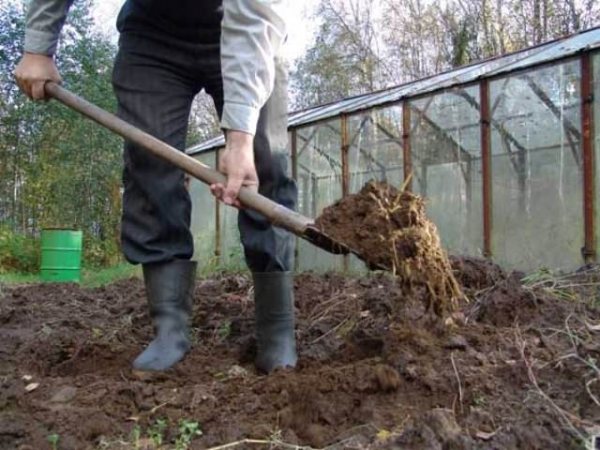

For the best result, five to ten grams of nitrogen fertilizer is added to it before and after flowering. There is no need to add nitrogen in autumn, but it is worth applying about 30 grams of superphosphate and 15 grams of potassium sulfate around each bush.
Ash as a top dressing is categorically not suitable, it lowers the acidity of the soil. From this, the plant develops chlorosis. But, if such a nuisance has already happened, then you can buy a special acidifier in the store and apply it according to the instructions. This will completely cure the plant. But do not just acidify the soil, it is harmful to rhododendrons.
If the leaves began to turn yellow, brighten, fall off, curl, lose their shine, then the plant clearly lacks nutrients and minerals. The same is evidenced by the absence of buds and their setting, a decrease in the number of new shoots.
When and how to plant rhododendrons outdoors
Landing dates
You can plant rhododendrons both in spring and autumn. If you decide to plant in the spring, then it is advisable to have time before the plant blooms, in other words, depending on the region (in the Central lane, the Moscow region a little earlier, in the Urals and in Siberia - later), it may be April - May. Autumn planting of rhododendron is best done in early autumn, it is recommended to be in time before the second half of October. These terms are explained by the fact that wet and cool weather is ideal for the plant to take root in the garden.
Place in the garden for planting
Rhododendron, like all flowering shrubs, still loves the sun. Therefore, find a place for planting sunny or with light partial shade.It is good if direct and burning sunlight does not fall on the plant from 10-11 am to 4-5 days. Moreover, this shrub does not tolerate drafts, but it definitely needs to provide an influx of fresh air. For example, it is good to plant a rhododendron near fruit trees (the same apple tree), which would slightly shade the shrub during the day, at a distance of about 1.5 meters from the crown.
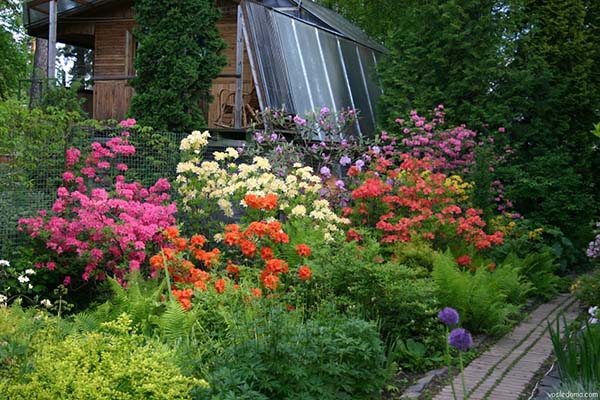

Advice! Deciduous rhododendrons need more sun than evergreens.
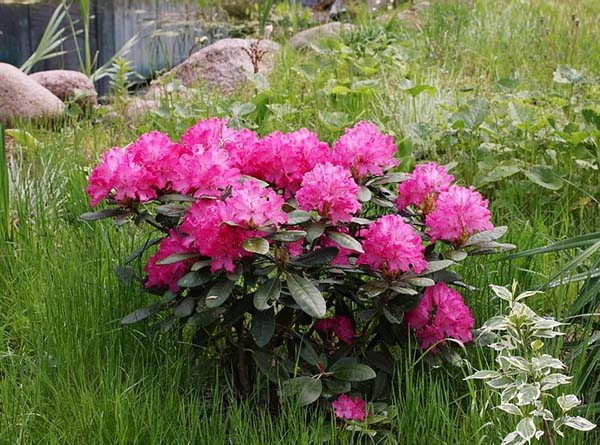

Landing pit and soil
Although the rhododendron pot is usually small, landing pit you need a large enough, it should be somewhere 3-4 times larger than the root system of the seedling. Dimensions (edit) the following are required: depth from 50-90 centimeters, width - 60-80 centimeters (depending on the size of the seedling and soil. If the soil is too clayey, then the pit should be larger).
Important! If the soil in your area is clay, then drainage material should be laid on the bottom by about 10-15 centimeters. As drainage, you can use any inert substance, that is, gravel, crushed stone, coarse sand is suitable.
If you want to plant several rhododendrons next to each other, then it is advisable to plant them at a distance of at least 1 meter from each other.
Rhododendrons love acidic soils. In ordinary (sandy loam or clay) plants, these plants grow very poorly, literally 1 season, and then they wither and disappear (as a rule, they simply do not survive the winter). Therefore, to fill the planting pit, you will need sour high peat... It is sold ready-made in garden stores, or you can dig it up in a forest swamp. You will also need coniferous litter (these are needles and twigs of coniferous trees that have fallen to the ground, for example, there is pine litter), you can also collect it in the forest, and you need to collect it not dry (it should be thrown back), but loose and smelling of mushrooms. You need to mix these components in equal parts.
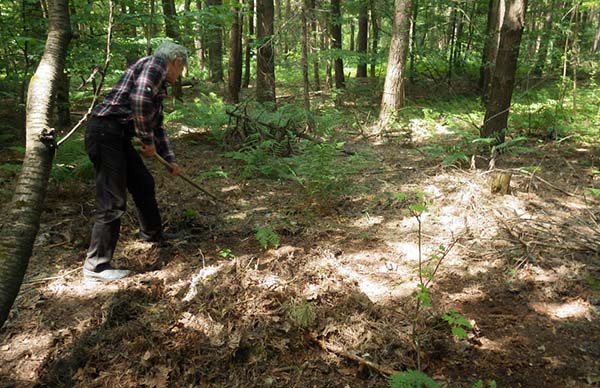

Another suitable for rhododendron soil mixture recipe: 6 parts of sour high-moor peat, 2 parts of pine bark and 1 part of garden (vegetable) land.
You can also purchase in the store special land for azaleas (this is a kind of rhododendrons).
Video: personal experience of growing rhododendrons
Direct landing
Step-by-step instructions for planting rhododendrons in open ground:
- Choose the best place at the summer cottage.
- Prepare the planting hole and potting soil to fill it.
- Fill the hole halfway with soil.
- Gently knead the pot, remove the seedling along with the earthen clod and place it on the ground.
- The root collar of the plant should be above ground level, so either add or remove the soil from the hole. These ornamental shrubs do not like when they are planted with a buried root collar.
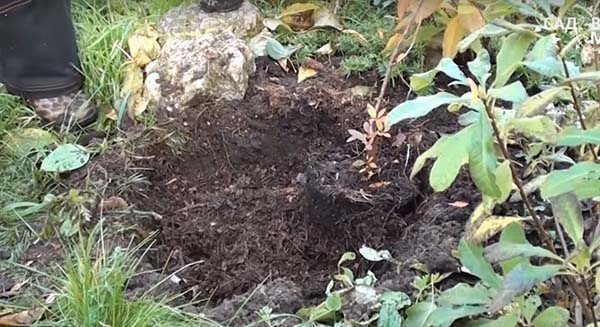

- Fill the remaining space with nutritious soil and then tamp down a little.
- Spill abundantly from a watering can, wait a little until the peat mixture settles, and then add more soil.
- It remains only to mulch the hole with the remaining coniferous litter or pine bark (about 7-10 centimeters). Mulch will help retain moisture and keep the soil from overheating. It will be very beautiful if you mulch the surface of the soil with cones.
Video: how to plant rhododendrons
How to insulate each type of garden azalea
Azalea is more sensitive to lack of moisture than extreme cold, so it is important to protect the plant from dehydration. Basic recommendations for species common in Russia:
- Deciduous. The bush reaches a height of 1.5, therefore, before wrapping the branches, they bow to the ground and sprinkle with a leaf mixture or peat.
- Japanese rhodondron. It differs in dwarfism, its height is up to 50 cm, therefore it is convenient to cover it with cardboard or burlap after a cold snap to -10.
- Evergreen.Young bushes are covered with spruce branches even in the south of Russia. Adult shrubs tolerate lower temperatures well, therefore it is necessary to cover the rhododendron for the winter in the Moscow region and in the Urals.
- Multi-flowered azalea. The plant is not afraid of a slight cold snap. After the temperature has dropped to -10, a frame is made of boards and wrapped in an air-permeable, non-woven material.
Gardeners recommend covering any kind of azalea for the winter, because the plant can be severely damaged by the wind, not frost. A winter without snow is dangerous for her.
Shop constructions
If there is no opportunity to build a shelter for a rose tree on your own or do not allow the opportunity, you can buy a ready-made one. Often such structures are a frame, accompanied by a special covering material. It is convenient to use the device - it is simply installed at the right time and removed in the spring, after the temperature has stabilized.
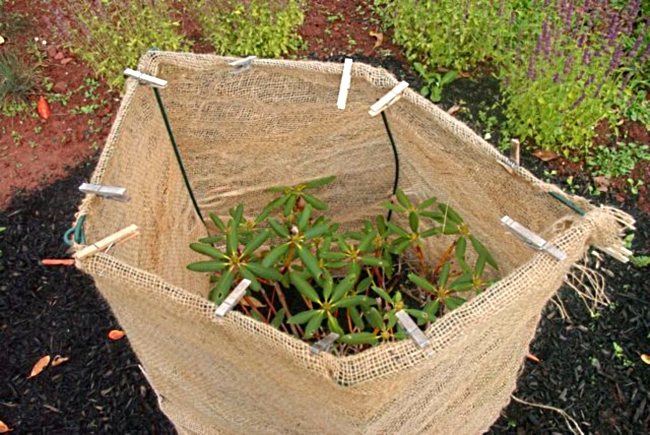

Self-creation
To make the frame, you will need tools:
- screwdriver;
- screws;
- hacksaw;
- jigsaw;
- saw.
For the frame, boards or timber are used; covering material is also required.
Construction instructions:
- The frame is made of boards or timber, fastened in a wigwam format.
- The height must be calculated in such a way that the structure is 20 cm higher than the branches.
- The material is pulled onto the frame so that the cover lies on the ground.
- The cover is spread out on the soil and applied with bricks.
The next way:
- A stool is made of wood and metal.
- The lid is made of sawdust pressed into a bar.
- The structure is covered with litrasil, its edges are pulled to the ground.
The disadvantage of the constructional solution is that, thus, only a low plant can be insulated.
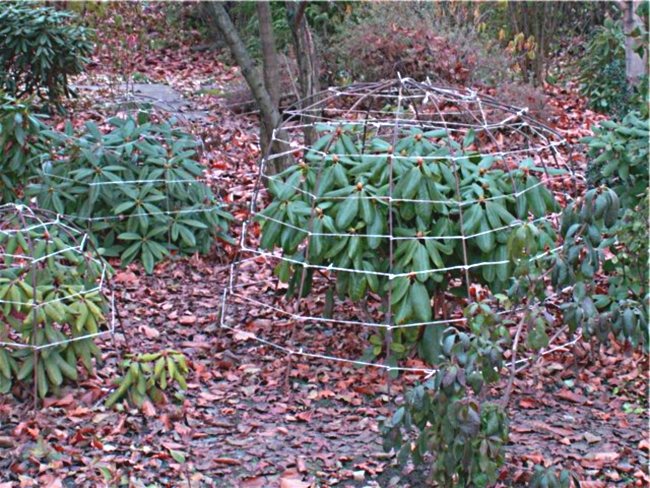

The easiest method:
- Small holes are made in a box made of thick cardboard for ventilation.
- The structure is installed on a bush and covered with an air-permeable material.
- The edges of the material are stretched along the ground.
The method is suitable for adult plants with a height of up to one meter.
Closing instruction
In general, the closure process includes:
- watering is stopped late in the fall, before the onset of frost;
- fertilize rhododendron with a potassium-containing and magnesium-containing composition;
- carry out formative pruning;
- treated for fungus and pests;
- arrange mulching;
- if the bush is tall, its branches bow to the ground;
- cover according to the chosen method.
Wintering ends in early March, after the ambient temperature rises.
Attention!
After wintering, the plant must be accustomed to sunlight gradually, therefore, after removing the covering structure, the azalea is shaded.
Terms when to carry out work
The optimal terms for creating a shelter and its elimination, depending on the region, are described in the table:
| Process | Middle zone of Russia, Moscow region, Ukraine | Leningrad region | Siberia | Ural |
| Wintering start | November | November | End of September - beginning of October | End of october |
| Awakening | March | March | Mid april | Early April |
The given terms are approximate, that is, the gardener must clarify the forecaster's forecast and adopt it. If, according to the forecast, the onset of winter is promised early, you need to have time to carry out all the work before that moment.
Outdoor rhododendron care
In order for the rhododendron to grow well and bloom profusely in your summer cottage, it needs proper and timely care.
Rhododendron, like all heathers, does not tolerate drying out of the soil. And the peat mixture in which this shrub grows dries up very quickly, especially in summer when the weather is hot. Therefore, it is worth paying attention to the plant regularly and on time to water.
At the end of summer (in August), experienced flower growers recommend stopping watering.
Advice! In the first 2 years, it is highly recommended to do surface spraying in dry weather, in other words, watering directly over the crown.
Weeds must not be allowed to grow in the near-trunk circle of the shrub. To avoid this, it is necessary at the planting stage to mulch the hole and, if necessary, add additional mulch, as well as weed and loosen.
Top dressing
In early spring rhododendron good feed any nitrogen-containing fertilizer that contains a minimum amount of potassium. For example, you can use ammonium nitrate and prepare a solution by taking 1 tbsp. a spoonful of fertilizer and dissolving it in 10 liters of water.
If your rhododendron has bloomed profusely, then to replenish its strength, you need a mandatory summer top dressing.
As for such dressings, it is advisable to make 2-3 dressings with acid fertilizers during the summer. For this, store-bought azalea fertilizers are great.
Video: when and how to feed rhododendrons
The second feeding of rhododendrons in the summer should be done at the end of July. For this, potassium sulfate should be used. To prepare the solution, you will need 1 tbsp. a spoonful of fertilizer and 10 liters of water.
Video: second summer feeding
Important! At the end of flowering in the first 2-3 years, it is advisable to promptly and carefully remove the faded inflorescences, otherwise they form seed material that draws strength from the rhododendrons.
After the rhododendron has faded, if it feels good and you take proper care of it, then it will definitely give young shoots. If they do not appear, then this is a clear signal that the care is incorrect or insufficient (for example, watering).
Video: caring for rhododendrons
Note! You can read more about caring for rhododendrons in autumn and preparing them for winter. in this article.
Video: preparing rhododendrons for winter
Rhododendron or Azalea - a short description of the flower
Rhododendron is a short shrub with dark bark, branches of which reach a length of 2-4 meters. Young shoots are covered with glandular-lowered scales, which disappear in 4 years. The leaves are alternate, with petioles, whole-edged, their length is 2 cm in a young plant and 8 cm in a mature shrub. The sheet has an elliptical shape, tapers towards the base, the edges curl down.
The ornamental value of the plant lies in its flowering. The flowers have a long stalk and are gathered at the end of the branch into a bouquet of 3-5 buds. Corolla - irregular, up to 5 cm in diameter, light yellow with a wide funnel and 5 lobes. The flower has 10 stamens of different lengths. The plant reproduces by seeds, they are small, ripen at the end of August. Growing an adult bush from seeds under normal conditions is difficult. Azalea has a pronounced, pleasant scent of green strawberries.
Garden azalea belongs to the Heather family. This genus is represented by shrubs and trees, deciduous, semi-deciduous and evergreen plants. The genus has more than 1000 species.
Interesting to know!
The name of the plant includes 2 words, rhodon translated from Latin means a rose, and dendron means a tree, therefore, among flower growers, Azalea is called a rose tree. In appearance, Rhododendron bears some resemblance to the rose - the queen of flowers.
In the wild, the plant is common in the following regions:
- Southeast Asia;
- Japan;
- America;
- South China;
- Himalayas.
Shrubs grow well near the seas, oceans, on the slopes of the mountains. They prefer partial shade. Flowers of different species of this genus differ in color, but also in size and shape.
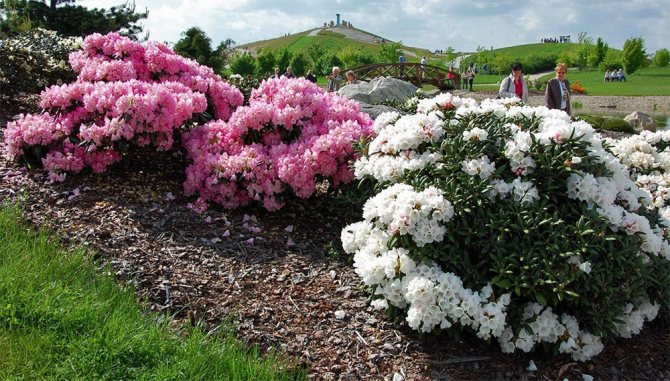

How to transplant a rhododendron to a new location
Sometimes it happens that the plant does not take root in one place, and it should be transplanted to a more suitable one. Rhododendrons are not afraid of transplantation, because they have a fairly compact root system, however, you should be guided by some rules for changing the place of residence of a shrub:
- As for the timing, replanting the rhododendron, as well as planting for the first time, is either in early spring or in the first months of autumn.
- It is optimal to handle shrubs in slightly cool and cloudy weather, but not in dry and sunny weather.
- When you dig up the plant, despite the fact that the root system is small, in no case should it be damaged.
- It is imperative to dig up the plant together with an earthen lump, which should not crumble when transferred to another place, therefore, the movement must be performed using a wheelbarrow, placing an earthen lump on it.
- In the first year after transplanting, it is advisable to cover the shrub for the winter with one of the popular covering materials (for example, spunbond), and this is done in order to protect the plant from burns.
If you liked the pleasant shapes and luxurious flowers of the "alpine rose" (another name for rhododendron), do not drive away from yourself the idea of settling this beautiful shrub in your summer cottage. The correct and energetic chores of planting and grooming will more than pay off with a truly unforgettable sight.
Video: planting and caring for rhododendron
These shrubs are great during flowering. At the beginning of the 19th century, rhododendrons began to decorate the gardens of Russia for the first time. Varieties, cultivation in the open field, planting, care, reproduction: we cultivate rhododendrons according to all the rules.
Description of rhododendron: varieties and varieties
The genus of rhododendrons is quite extensive - more than 1,000 species, which include various varieties of this wonderful plant. The natural area of distribution of rhododendrons is limited to the eastern countries: China, Japan, Korea, the Himalayas; some plant species are found in the Caucasus, North America, northern Africa and Australia. In European territory, two varieties of rhododendron grow in the mountainous regions of Germany.
Rhododendron is a magnificent plant with a long flowering period
The culture refers to flowering deciduous or evergreen shrubs of the heather family. The branches of the plant can have smooth bark or pubescence. Leathery, dark green small ovoid leaves are sometimes pubescent. Bell-shaped flowers, funnel-shaped, simple and double. The color of the petals varies depending on the variety: white, pink, lilac, red, purple. Modern varieties of rhododendron are yellow and orange in color. Numerous small seeds ripen in capsules.
Rhododendrons, the cultivation of which on the territory of Russia is most acceptable, is limited to 26 species belonging to three groups of plants.
- Evergreens are tall shrubs that do not shed their dark leathery foliage even in winter. Large flowers are painted in different colors and tones. Growing evergreen rhododendrons in the open field requires compliance with a number of necessary rules: plants are placed in places with diffused shadow; the soil for them should include a large amount of peat.
Rhododendron evergreen
Tip: It is important to choose the right neighborhood for evergreen rhododendron species, especially when decorating territories in landscape design. It can be all types of conifers, heather, ferns grown in the open field.
- Intermediate (semi-evergreen) - low shrubs that winter well under a layer of snow. The plant is characterized by a compact form, a huge number of flowers during flowering. In winter, most of the leathery leaves fall off, leaving only the whorl of leaves at the ends of the branches, from the center of which new foliage grows.
Semi-evergreen rhododendron
- Deciduous - rhododendrons of this group are most adapted to the conditions of the Russian climate. The cultivation of these plants is not difficult, and the plants themselves do not need to be specially adapted in winter. Blossoming in spring, repeated in autumn.
Deciduous rhododendron, grade "Fireworks"
Planting a plant
Rhododendron: planting and caring for plants in compliance with agrotechnical rules - plant transplantation is allowed in spring and autumn. In autumn - in any of three months, in spring - in warm, well-established weather, when the soil is no longer frozen (usually April or May).
The choice of a place for planting a plant must be carried out with special care. Planting rhododendrons should be protected from the prevailing wind and direct sunlight. It is important that the shrub is accessible for viewing, then the decorative appearance of the plant during the flowering period will decorate the territory and please the eye.
Tip: Before planting the plant from the container into the open ground, it should be thoroughly saturated with water.
A planting hole for rhododendron bushes is prepared based on the actual size of the root system, and should be 2 times larger in volume. The natural soil should be removed completely. To plant a plant, it is required to prepare a special earthen soil consisting in equal parts of heather soil; peat; garden soil or leaf humus; rotted manure; needles (pine).
It is very important to plant the plant correctly, then it will quickly take root.
The prepared pit is filled with a mixture, a place is prepared in it for planting a rhododendron bush, which must be placed strictly vertically. The soil around the root system of the plant must be tightly squeezed - the formation of voids and "pockets" in the planting soil is not allowed. At a high level of groundwater, it is necessary to provide for the laying of a special drainage layer at the bottom of the pit. After planting, the top layer of soil should be mulched with peat chips.
Rhododendron: proper watering
Watering the planted plant is carried out at the time of planting, - abundant, sufficient to moisten the soil to a depth of 20-30 cm. Subsequent watering of the rhododendron should be done with soft, acidified water, with complete moistening of the soil.
Tip: When planting a plant with buds, it is necessary to remove most of them.
Plant care
A transplanted plant requires attention and careful care. In addition to regular abundant watering, the rhododendron needs spraying over the foliage, especially when planting in late spring. The soil needs to be mulched to maintain sufficient moisture. When mulching, you should choose options that increase the acidity of the soil.
The plant needs regular watering
The root system of rhododendrons consists of delicate, fine hairs, similar to matted hair, so loosening the soil, especially deep, should be excluded from flower care measures. Weeds growing next to the plant need to be removed periodically.
The appearance of the plant will immediately inform about the lack or excess of water - the leaves of the rhododendron will begin to turn yellow and fall off. Watering is required in sufficient quantities, but without overflow, this is one of the main rules for caring for a crop.
To ensure proper care of the rhododendron, it is important to timely prune the overgrown bushes. Places of cuts to prevent infection of the plant are covered with paint or garden varnish.
Bushes need to be pruned periodically
Compliance with simple plant care requirements will allow you to grow a wonderful flowering bush.
Fertilizing and feeding rhododendron
In the first year, the transplanted plants already require careful fertilization, which is applied in a highly diluted form, in small portions. The plant itself will signal the need for fertilization: it will stop growing, discard the foliage or the leaves change color, the formation of flower buds will stop.
Organic fertilizer for feeding rhododendron bushes - semi-decomposed manure, which must be infused in water. Top dressing is carried out with an aqueous solution of manure.To increase the formation of flower buds, as well as to extend the flowering period, granular superphosphate, or double superphosphate, is used, which is scattered over the moist soil under the plants. The plant is also useful for fertilizing with microelements, - fertilizers are applied in the form of watering or spraying the green mass of the bush. Intensive fertilization of the bushes is required until the end of August.
Rhododendron before flowering
Reproduction of rhododendron
Growing rhododendron involves plant propagation by layering and seeds, dividing the bush, grafting, cuttings.
Seed propagation Is a great way to get plants with improved traits. Sowing is carried out from the end of December to the end of March. The second period suitable for seed reproduction of rhododendrons is the end of November.
Sowing seeds is carried out in shallow bowls or boxes filled with a nutrient mixture of peat, sand, coniferous and sod land, taken in equal proportions. The seeds are pre-soaked for a day. Sowing is carried out on the top layer of the soil, without embedding deep into the soil. The sowing is moistened by spray. It is required to provide the seedlings with a 12-hour fluorescent light. The timing of seed germination depends on the variety. The first flowering of seedlings is possible in 3-4 years.
Rhododendron seeds
This method has its advantages, but with seed reproduction of rhododendrons, it takes up to 5-6 years to obtain full-fledged plants.
Faster new plants can be obtained with vegetative methods of culture propagation: cuttings, dividing the bush, rooting of cuttings.
Diseases and pests
Fulfillment of the requirements for agricultural technology of rhododendrons guarantees excellent growth and development of plants. However, repeated waterlogging or overdrying of the soil, alkaline reaction of the soil, sunburn of leaves, can provoke a surge in crop diseases.
Plants can be damaged by spots, rust and chlorosis. Disease control measures - improving the conditions for keeping plants, the use of special means to combat diseases. Often, rhododendron diseases are caused by pathogenic fungi: gray rot, fusarium, late blight.
Spotting - a fungal disease of the rhododendron
Pests that damage rhododendrons: slugs and snails that eat young leaves and buds. The collection of these pests is done manually. In addition, the plant is harmed by: bedbugs (rhododendron), spider mites, mealybugs, weevils, scale insects, rhododendra fly. Pest control is easy with systemic insecticides.
Rhododendron: combination with other plants
Planting plants in combination with conifers and a group of heathers has a positive effect on the development of rhododendrons. It should be remembered about the height of the rhododendron bush. Low cultivars should be located away from the dense shade of mature trees, but avoiding direct sunlight.
Blooming rhododendron perfectly sets off conifers
An excellent combination is observed when located next to the rhododendrons of shade-loving ferns and host.
Rhododendron in landscape design
In landscape design, rhododendron is an indispensable attribute for planting in partial shade. The huge advantages of the plant are its long and very decorative flowering. Rhododendrons are widely used in the design of heather gardens, as an addition to the planting of pine groves. The plant looks great in mono plantings.
Rhododendron in landscape design
Low-growing varieties of rhododendrons are planted near alpine hills, in mixborders and in decorative flower beds.
Planting a garden rhododendron: video
Types of rhododendron: photo
Preparing for winter
Many people believe that it is necessary to take care of the plant only during the flowering period, but this opinion is erroneous, because the plant also needs help in the autumn-winter period. In order for new and fluffy buds to appear next year, already wilted inflorescences should be broken off. Do not forget about winter feeding, because during the cold season there are not many sources of feeding. Do not stop watering and acidifying the soil with rhododendrons, before winter do abundant watering. If necessary, trim off unnecessary and dry branches. And be sure to cover the plant for the winter.
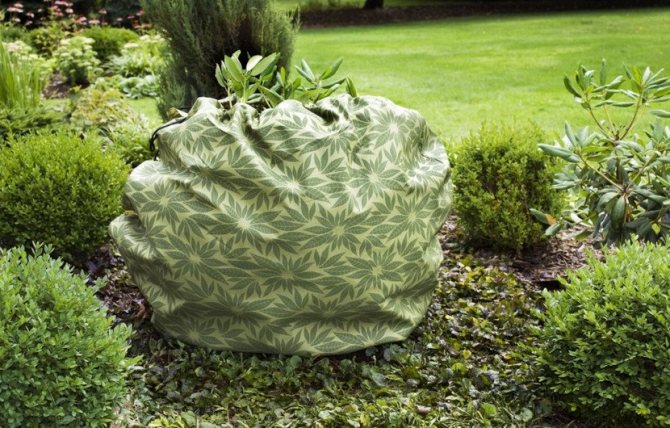

Features of the life cycle of azaleas in the autumn period
In the autumn, the plant is prepared for wintering (pruning and shelter). The flowering and state of the rhododendron in the next season depends on the quality of these actions. It is important for a gardener to know the slightest nuances and rules for the autumn preparation of flowers for hibernation.
Reference. The word "rhododendron" literally translated from Greek means "rose tree" or "tree with roses", but it has nothing to do with a rose. Their connection is only in the beauty of flowering, a wide variety of types and varieties.
In the fall, pruning of handicraft plants is done - one of the obligatory and very important processes. All perennial plant species are exposed to it, rhododendron is no exception.
Types of possible trimming:
- sanitary;
- anti-aging;
- formative.
In late autumn, as soon as the first frosts come, the rhododendron bushes are tied with a rope and covered with plastic wrap or a bag. You need to remove this makeshift hut immediately after the snow melts.
The deciduous species tolerates winter well in temperate climates. Can survive frosts up to 10 degrees without shelter. If the temperature drops below, you will have to use burlap.
Evergreen varieties of rhododendrons are less tolerant of low temperatures. Bushes need additional shelter, as they often break branches under the weight of snow or strong winds. It is best to build a small insulation structure above the bush to protect the plant.
Planting dates depending on the season
In temperate latitudes, rhododendrons in the garden area are grown exclusively for winter-hardy varieties. Disembarkation takes place from early April to mid-May, as well as throughout the fall. It can be produced in any growing season, except for the beginning of flowering and 10 days after it. However, experienced gardeners still recommend a specific planting period: from April to May 15. But the varieties planted earlier still have their own advantage: by the May holidays, they already bloom in a violent color, which looks very impressive.
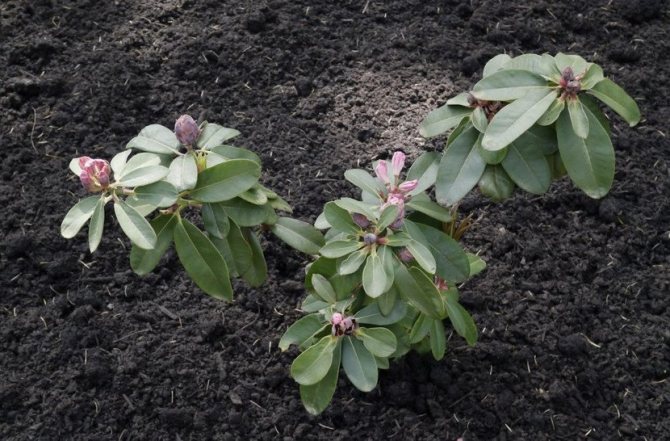

Which way to choose to plant a plant?
The choice of method depends on the characteristics of the selected type.
On a note. Wild rhododendrons are propagated vegetatively or obtained from seeds. Varietal are complex hybrids for which only vegetative variants are appropriate.
The main methods of breeding and planting:
- Sowing seeds, growing seedlings and further growing in containers.
- Planting cuttings.
- Planting cuttings.
- Splitting the bush (suitable for old and growing bushes).
History
For a very long time, the plants, now called rhododendrons, have not been singled out as a separate genus. At the end of the 16th century, the rusty rhododendron was first isolated, at that time the only representative of the genus.
At the end of the 18th century, attempts were made to systematize information, as a result of which several species were identified. Then the available information was changed and supplemented, as a result of which the currently available classification was collected. It was decided to include only species growing in greenhouse conditions as azaleas.
Step-by-step instructions on how to carry out cuttings
The presented algorithm of actions is suitable for deciduous species. Reproduction takes place by cuttings.
Required inventory
For planting, boxes or boxes are required. If it is necessary to accelerate growth, then cuttings can be planted in greenhouses or hotbeds. They are also planted in open ground, but regular watering, growth control and adherence to suitable conditions will be more difficult to carry out.
A place
Rhododendrons are quite whimsical plants. They are not suitable for planting in dry and cold climates. They love shady places, coolness and water, but they can easily bloom with constant exposure to sunlight. The best place to plant is in the northern, shady area of the site. The soil should be loose, filled with humus.
Plants take root ideally near bodies of water with humid air. If there is no water nearby, the bushes need to be sprayed once a week before flowering. It is recommended for the plant to choose the right neighbors.
Do not plant bushes next to trees such as:
- Linden;
- chestnut;
- maple.
The root systems of these trees are at approximately the same depth and can take all the nutrition from the new plant.
Note! The best neighborhood option is apple trees, pears, conifers.
Preparing the soil
For cuttings, special ready-made sour soil mixtures or self-prepared soil mixtures are used. A mixture of peat, coniferous soil and sand in equal proportions is suitable for the plant.
Process
Rhododendrons have a fibrous root system. Plants easily tolerate planting, but die when flooded. When planting cuttings, you need to make a shallow hole so that they grow at the level of the soil, do not deepen after the soil subsides. If underwater waters are close to the site (the level is less than 1 m), good drainage must be done in the landing pit.
It is better to harvest seedlings for planting in the second half of July. To do this, cut the leaves from the shoots together with the axillary bud and wood in the form of a shield with parallel edges of short length. For deciduous species (azaleas), it is better to choose apical cuttings. If there are many flowers on the bush, then they need to be cut so that all the forces of the plant are directed to the rooting of growth, and not to its flowering.
From cuttings that are cut, it is necessary to remove the lower leaves, leaving a couple of upper leaves. It is not necessary to shorten the remaining leaves on the cuttings. The cut is performed at an angle of 45 degrees.
There is also preprocessing of cuttings:
- Soaked in growth stimulants. It is necessary to lower the lower sections into the rooting solution for about a day.
- The containers are filled with soil and leveled.
- Leafy cuttings take root within 5 months.
First watering
The first time to water the plant after planting is necessary for 3-5 days. Wherein it is important not to flood the roots, moisture should not stagnate. Further watering schedule: once a week.
Outdoor care
Important! The main components of proper care are regular and correct watering, spraying, fertilizing, creating a bush shape, preventing and combating diseases and parasites.
What is important for a gardener to consider:
- It is forbidden to loosen the soil near the rhododendron bush. This is due to the fact that the roots of the plant are close enough to the surface. Pulling weeds is best done by hand without using garden tools.
- In arid autumn, the flower requires abundant watering (on average 10 liters of water). In a rainy autumn, you can forget about watering.
- You need to water the bushes with soft water (rain or settled). The frequency of watering can be determined by the leaves. If they become dull and begin to lose elasticity, then it's time to start watering. The soil should be moistened to a depth of 30 cm.
- Do not flood the roots of rhododendrons with water. This plant is very sensitive to water oversaturation in the roots, therefore they react exactly as they do to drought (wither).
- In November, they begin to insulate each bush, laying a layer of peat next to it.
Errors
When growing azaleas outdoors, even experienced growers make serious mistakes:
- Improper soil preparation - the shrub grows well only in acidic soil. High acidity leads to chlorosis.
- Unregulated humidity conditions. It is dangerous for a plant to dry out an earthen coma and overflow. You need to water it as the topsoil dries out. Good drainage is essential.
- Lack of light or too much light. With a lack of light, the shoots of the bush are stretched out, and there is no flowering. An excess of sunlight leads to burns, therefore, you need to place the azalea in a moderately lit area.
- Lack of nitrogen. The shrub requires generous fertilization with nitrogen fertilizers, like other flowering plants.
- Damage to shoots by wind and snow. A reliable shelter for the winter helps to avoid this problem.
It is easier to prevent the occurrence of such problems than to eliminate their consequences later. It often happens that it is impossible to save a young bush due to the carelessness of a specialist.
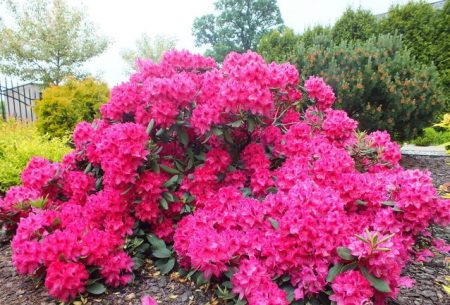

You may be interested in:
Frost-resistant rhododendrons - the best varieties Rhododendron is an exotic plant that cannot always withstand the harsh climate of Russia, so for planting in ... Read more ...
Difficulties and problems
Drying of the kidneys and stunted growth are common problems. The situation can be corrected by daily watering with warm water with growth stimulants. The presence of grass, hay, straw or other mulch that has been used in the past can negatively affect the condition of the bush. Also, these materials can become a source of pest infestation.
If the disembarkation occurs in late autumn, the soil can be pre-spilled with hot water - this will kill possible parasites, will facilitate the adaptation of the bush.
Breeders have bred many varieties and types of rhododendrons. They live long, bloom up to several months a year. They are often used to decorate flower beds, in the field of landscape design. The flowering bush pleases the owners and brings aesthetic pleasure. Proper care, timely control of diseases and pests is a guarantee of the health and beauty of the shrub.
Do you want to settle a bush of an attractive and flowering plant on your site? We will tell you when and how to properly plant rhododendrons in a flower garden and take care of them after planting.
Rhododendrons are rightfully considered the most beautiful spring-flowering shrubs. They have attractive evergreen leathery leaves. And the main decoration of the bush is large inflorescences. But to enjoy this beauty, the plant must be planted in a suitable place.
Reproduction
Reproduction is perhaps one of the most interesting gardening processes. It is also a great way to save money or make money. Since this does not require large costs, and much more can be obtained from one bush and a package of seeds. Below is a look at how to grow a good rhododendron in the Moscow region in different ways.
Cuttings
The grafting method is a bit lengthy and will not work for the impatient. Cuttings are used only from last year's shoots, semi-lignified tops are suitable, completely lignified, do not cut, they will take root for a long time.
Did you know? Rhododendron is the state symbol of Washington. In Nepal, it is considered the national flower, but the eastern culture attributes the rhododendron to a symbol of female seduction.
Cuttings are carried out in mid-July - early August. To do this, break out annual shoots about 10 cm long and cut off the buds from the tops. In large-leaved species, the leaves are cut off by a third so that moisture evaporates as little as possible. From the lower part of the shoot, leaves are removed altogether, in the ground they can rot, leave, about 4-6 leaves.
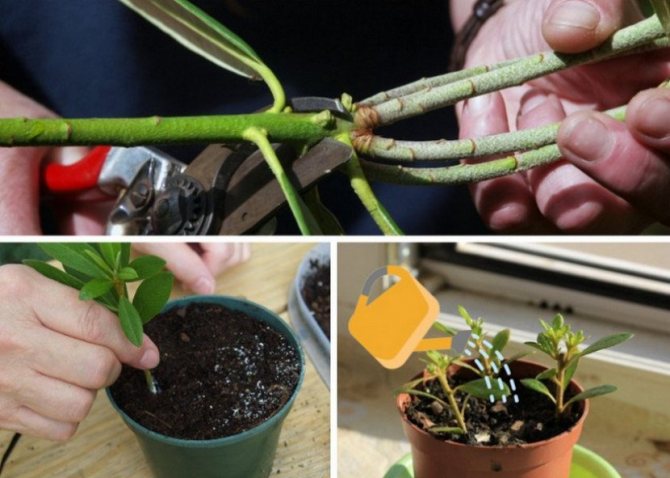

A small cut is made at the bottom of each cutting so that the roots appear much faster. Then they are treated with a stimulant and planted. The pits for planting are made with a pointed stick, so the prepared cutting will not be damaged. They are planted 2-3 cm. The compacted soil is watered abundantly with water.
Layers
This method is quite simple, it will suit absolutely any gardener, especially one who does not need a lot of copies to be obtained. The procedure is carried out in late spring - early summer. To do this, choose the most flexible shoot from under the bottom of the bush and press it to the ground, pressing it by 5-10 cm.Be sure to fix it with something and sprinkle it with a mixture of soil and peat. Bring the top part out and attach to the support.
Water the cuttings abundantly, the soil should not dry out. For the winter, the plant is covered with mulch and spruce branches. In the fall, next year, it is possible in the spring, the rooted layer is cut off and moved to partial shade. After 2-3 years, the layering can be safely transplanted to a permanent place.
Seeds
Reproduction of rhododendron by seeds is a rather complicated and costly method. This method must be approached responsibly and confidently because the seeds require a lot of maintenance. This includes: suitable temperature, light, air humidity, picking, watering, replanting. You will also need to set aside a secluded spot for the seed containers.
Sowing is carried out from late February to early March. Prepare filled containers with a mixture of sand and peat, some housewives add needles. There is no need to tamp the soil, keeping a distance of 1–1.5 cm, sprinkle the seeds without sprinkling and cover with foil. The containers are stored in a warm and bright place at a temperature of + 25 ° C. Remember to ventilate them.
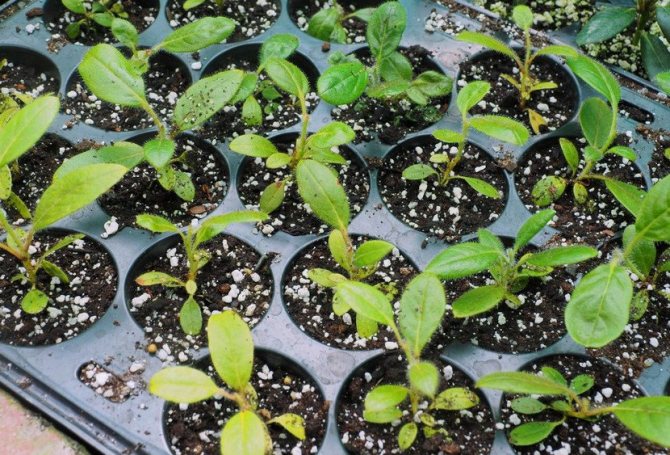

Three weeks later (this is the period when the first shoots appear) the film is removed and the containers are taken to a cooler place with a temperature of + 12 ... + 15 ° С. With the onset of warmth, the seedlings are taken outside for a couple of hours, and in July they are completely mastered in the street partial shade.
Site selection and preparation of the landing pit
Rhododendron prefers sunny or semi-shady areas, where gusty winds do not roam. The soil for the plant should be neither too light nor too heavy. The shrub tolerates drought and excess moisture equally poorly. Therefore, in growing rhododendron, the most important thing is to find a middle ground. Also, keep in mind that the acidity level of the soil should be between 4-5.5 pH. With an excess of acid, the shrub runs the risk of developing chlorosis.
Prepare a soil suitable for rhododendron as follows: mix sour peat, garden soil and pine bark in a ratio of 3: 0.5: 1. Then check the acidity level with litmus paper. In addition, perlite can be added to the soil mixture.
Dig a planting hole 0.5-1 m deep and 1-1.5 m wide. The hole should be 3-4 times the size of the root system of the rhododendron seedling.
Further care
Rhododendron is a finicky plant and therefore needs constant care. Requires timely watering, feeding, weeding, spraying, pruning, protection from various diseases and pests. Loosening should be done with extreme caution, because there is a possibility of damage to the superficial root system. And digging should be abandoned altogether. Weeds must be weeded only by hand, without the use of garden tools.
How to plant a rhododendron correctly?
Put drainage (expanded clay or gravel) at the bottom of the pit, then fill the hole halfway with the prepared soil mixture. If you purchased a seedling with an open root system, spread the roots of the plant and carefully place it in the hole. Sprinkle abundantly with water at room temperature so that the roots go deeper into the soil. Fill the voids with the remaining nutrient soil, then lightly compact the earth, pour and mulch with pine bark.
Plant a seedling with a closed root system together with an earthen clod using the transshipment method.
Rhododendron planting instructions
- Dig a planting hole: the depth is 31-41, and the width is 55-75 cm (deeper and wider than the root ball twice). The size is due to the fact that the root system grows more in breadth than in depth.
- At the bottom, make a drainage layer - 8-10 cm from broken brick (red only), granite rubble, sand, pebbles or fine gravel.
- When planting a seedling, water it abundantly, and if a container with a dry earthen clod, then soak it for 60-150 minutes (until air bubbles stop coming out) in water to saturate it with moisture.
Instead of an afterword
Of course, it is not so easy to grow beautiful exotic plants on the site. The best rhododendrons for the Moscow region are those that are frost-resistant. They take root well in our latitudes, but require careful care. By following all the rules and recommendations, you can get a beautiful, abundantly flowering plant that will delight you for more than one year. Although the cultivation of rhododendrons in the Moscow region is fraught with some difficulties, the result is worth it, a year after planting exotic plants on the site, he will be able to please you with the first flowering, the abundance of which will depend on your care.
Winter shelter for rhododendron
The main purpose of the shelter is to protect the rhododendron from strong winds and heavy snow, they are more harmful than a low stable temperature.
- After the arrival of stable cold weather (late October - mid-November), the branches must be carefully tied. Tie a tall bush to a support. And flexible species (Schlippenbach, some hybrids) should be tilted for wintering under the snow (at least part of the bush) and imagine how it will lie down so as not to break the stems.
- Drive a high stick near the bush and put a cover made of white burlap, agrofibre or light fabric (sheet, duvet cover) on the bush, or cover with lutrasil (spunbond). Such a shelter will protect the plant from the scorching spring sun, the branches will not get tangled and will easily straighten out in the spring. And due to the stick, the snow will roll down and the branches will remain intact.
- Instead of a stick, you can drive supports in the corners and attach a covering material (a hut, frame or house) to them, so that if a lot of snow falls in winter (100-140 cm in height), it does not press the branches to the ground.
Then, in the spring, the bush will need more strength to restore the shape of the stems, and flowering will worsen. You can put spruce branches inside.
Advice
- Covering with a cover made of fabric or burlap is useful for all types of rhododendrons that are under the sun in winter. Especially important for evergreen specimens.
- For a low bush, you can make a standard frame air-dry shelter, which is used for covering, for example, or surround it with spruce branches ("hut") and cover it with a box / box on top.
- Shelter for the winter is especially important for flower growers of the Middle Lane (Moscow region, Rostov-on-Don, Nizhny Novgorod), since thaws occur in winter (even at the end of December - beginning of January).
- According to the reviews of flower growers of the North-West (Leningrad Region), species rhododendrons winter well without any shelter and do not break, burn and freeze out. All thanks to the proximity of the sea (high humidity).
Why hide
Preparing plantings for cold weather is part of caring for plants that remain on the site. It is carried out in several ways, which allows you to see the flowering of the shrub in early summer.
Rhododendrons do not belong to thermophilic crops, so do not immediately "hide" them under a film or create another shelter. When the temperature drops below 10 degrees with a minus sign, it is worth starting work.
Why flowers cannot hibernate in their usual conditions:
- In autumn, buds ripen on the shoots, which then turn into ovaries.
- If you expose an ornamental plant to high (low) temperatures, the buds will dry out and fall off.
Important! To see flowers on the site and enjoy their beauty, you will definitely have to prepare rhododendrons for wintering.
When creating a shelter for shrubs, think about the fact that it should not be too "warm", will do:
- sprinkling with peat, foliage and spruce branches;
- less often synthetic materials and frame structures are used.
The erected shelter is reliable, but lightweight. This will allow rhododendrons that are not too frost-resistant to survive the winter.
Stages of procedures aimed at preparing for wintering:
- Soil mulching is where to start.
- Cover the base of the bush with coarse sand so that the bark does not melt in the spring.
- Tie the bush to a support and sprinkle it over.
All of the above manipulations are carried out in mid or late November, when the temperature “outside the window” stabilizes.
When to start?
You need to start gradually, however, you should not rush with it:
- First of all, you need to mulch the roots.
This should be done as soon as the low temperature is established. Light frosts up to -4 will not damage the rhododendron, and early mulching can cause the roots to decay. It is not necessary to spud the plant. - Shrubs should be covered after mulching.
It is recommended to do this in late autumn, when the temperature drops to -10, although the frames themselves for shelter can be placed even before frost.It is important that the leaves and branches of the plant do not touch the frame; there should be an air cushion between them and the shelter. The shelter must be designed so that snow does not accumulate on it. Otherwise, the branches of the plant can be damaged from severity. The most important condition is to cover the plant before the first snow.
- In the fall, anti-aging should be carried out.
It is better to carry it out 2 weeks after fertilizing the soil, and the shrub should not be drastically cut off. Better to do it gradually. For rejuvenation, shoots of deciduous rhododendrons can be cut by 0.3-0.4 cm.
When preparing for winter, the plant should not be dug up or transplanted. Rhododendron responds well to transplantation and this is done simply due to the presence of a superficial root system, however, it is not necessary to do this before wintering.
If it is necessary to transplant a bush, it is better to do it in early spring or late summer, when the air humidity is high enough and the temperature is comfortable.
Pruning
Rhododendrons are pruned in the spring. The exception is azalea. This plant is pruned after the complete flowering cycle, as well as after transplantation.
If the azalea has grown strongly and closed the garden paths or the windows of the country house, shoots 4 cm thick are cut off from it and the wounds are smeared with garden var. Within a year after such pruning, the bush is renewed due to the awakening of dormant buds.
Recent Entries
Gardener's lunar calendar for 2020: we do it right 3 reasons, make a reservoir in the country: we plan a new season Note for gardeners: 7 useful things to save energy
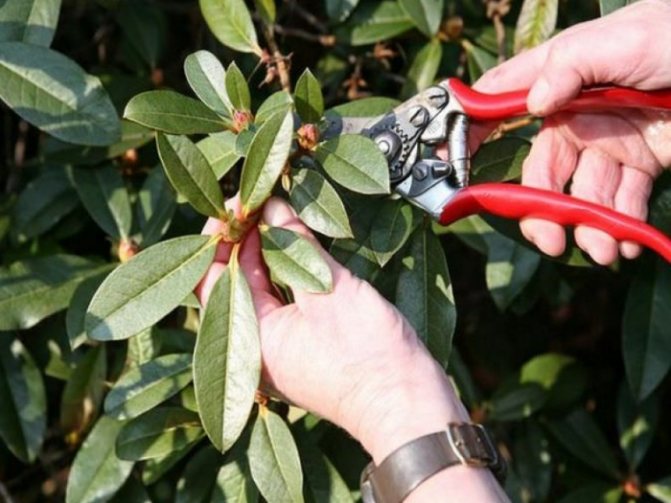

Pruning shrubs is required to renew and awaken dormant buds
Anti-aging pruning is required for old shrubs and plants affected by frost. They choose the oldest shoots and shorten them to 40 cm. The bushes are rejuvenated in two stages, half a bush every year. With such a rarefied interval, plant renewal is less painful.
Training by area
As mentioned above, rhododendrons are quite winter-hardy, and many varieties in the temperate continental climate of the Moscow region or the Volga region can winter without shelter. Closer to spring, it is enough to simply shade them so that the wind and sun do not damage the shoots. Shelter is necessary only in those regions of the middle zone where thaws often occur in winter.
For northern regions with long and frosty winters, it is better to choose winter-hardy varieties, but they also need solid shelter. Evergreen shrubs, in addition to the frame and insulation of the roots, are recommended to be completely covered with foliage, straw, or to fill the space in the shelter with these materials.
Origin, natural habitat
Rhododendrons are the name of a genus that includes many species of deciduous, semi-evergreen and evergreen shrubs and trees.
To create the most favorable environment for development, it is worth remembering their habitat. The geography of distribution is quite wide. These amazing shrubs prefer places with high humidity - the coast of the seas, oceans, large rivers. You can meet them on semi-shaded areas or on the northern slopes of the mountains.The soil in the areas of growth has an acidic environment, rich in nutrients and moisture permeability.
Growing features
Alpine rose refers to plants that need to be planted correctly, and then for many years you can limit yourself to minimal care. In the first year after planting, it is important that the plant does not experience a water shortage. The planting hole should be constantly wet, but you do not need to loosen it, since you can disturb the young growing roots, which will be located in the surface layer of the substrate.
The weeds that appear in the planting hole are pulled out by the roots, without digging. It is better to use soft water (not well water) for watering.
Rhododendrons love feeding. Keeping in mind the fragile superficial roots, it is better to use solutions for feeding not granules and powders, but solutions. The usual Kemira Universal works well. The granules are dissolved in water according to the instructions and the plants are watered every two weeks.
In early July, the plants are fed for the last time. For this, potassium sulfate is used - a teaspoon per 10 liters of water for young plants and two teaspoons per 10 liters for adults. In July-August, no feeding is carried out.
What can not be fertilized with an alpine rose:
- ash - it alkalizes the substrate;
- manure and manure compost - fungal diseases will appear.
Growing rhododendrons is often accompanied by such a phenomenon as chlorosis. The leaves turn yellow, while the veins remain green. Symptoms indicate a change in the pH of the substrate to the alkaline side.
The growing conditions for rhododendron are such that the plant can only survive in acidic soil. To eliminate chlorosis, acidifiers are used - special preparations that can be bought in garden stores. Industrial acidifiers contain a lot of nitrogen, so they can only be used in spring.
For the prevention of alkalization, you need to mulch the bushes with rotted needles annually. No special measures against chlorosis will be required if you use special fertilizers for rhododendrons to feed the plants and mulch the planting hole with pine or spruce needles two or three times a season.
Special studies have helped to find out the correct thickness of the mulch layer in winter, depending on the size of the bush:
In the spring, the mulching material is lightly raked away from the bush, freeing the root collar.
Most ornamental shrubs have a sloppy crown shape and need pruning. This is not the case for rhododendron. The Alpine rose boasts an absolutely correct crown - round or oval - in shape. You do not need to trim it, it is enough to do only sanitary pruning.
It is not necessary to prune branches even after transplanting, since the plants tolerate it well, and the work of the roots in a new place does not stop.
Rhododendrons bloom profusely every year. To prevent flowering from becoming less abundant, it is necessary to prevent the formation of seeds. For this, faded inflorescences are removed from the bush. In place of each broken off inflorescence, 2 new flower buds are formed.
The leaves will tell you about the lack of nutrients - they turn light green, stop shining. Shoot growth decreases, flowering becomes more restrained.
How to choose the right seedling for planting
The most important rule is to buy seedlings only in specialized nurseries or from well-known flower growers - breeders. This will guarantee that the purchased seedling will be of exactly the type, variety and age that the buyer has chosen. Plus, the seller, who values his reputation, will not refuse advice about planting and growing a flower.
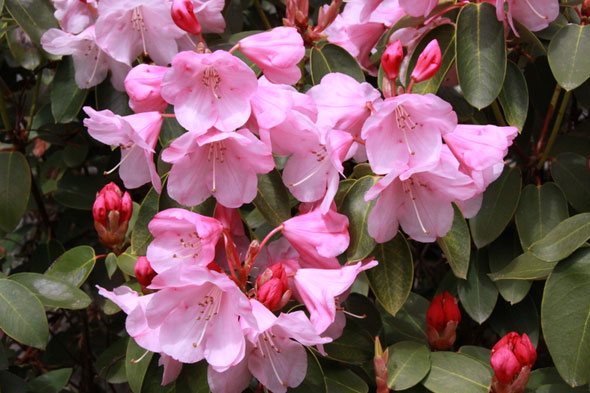

Plants brought from Holland or Poland are often sold at markets, sales in garden centers. They look beautiful, but they are not at all adapted to our conditions and will bring nothing but disappointment to their owner.
Rhododendron seedlings can be grown from seed or cuttings.Saplings of the same age grown from seeds are more compact, from cuttings larger, more branched. It is better to take copies of 2 - 4 years old.
Be sure to evaluate the appearance of the bush - the leaves are bright, smooth, without spots and swellings. The trunk is dry, without damage to the bark.
Tips from seasoned gardeners
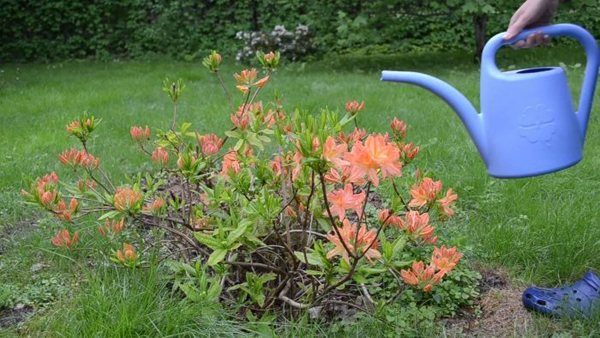

Rhododendrons are often found in home gardens and parks in many regions of Russia. Experienced gardeners who professionally grow shrubs know well what kind of care they need before winter, they do it according to all the rules. In order for even novice growers to know how to prepare rhododendrons for winter, there are several tips.
Since autumn, water-charging watering of the bushes is carried out, since they cannot do without a moisture reserve during this period. Watering is carried out in dry weather, as the soil dries up under the bushes. Water for these purposes is taken only soft and settled! If necessary, it is acidified with citric acid or lemon juice.
After watering, the land is necessarily mulched so that the moisture does not evaporate, but gets to the roots. Watering continues even after the arrival of cold weather, and stops only after the ground freezes.
To protect against melt water, an earthen mound and a groove are formed around the bush at a short distance from the base.
Evergreen rhododendron species require more careful shelter than deciduous ones.
So that there is no stagnation of condensate under the covering material, a piece of polypropylene tube is placed under the film, which will be an air outlet.
Opening shrubs in the spring immediately after warming is impossible without preparation, it is better to first open the bush for a while.
Early opening can lead to sunburn and cracking of the bark on the stems, leading to bush disease.
Rhododendrons are a real decoration for any garden. These beautiful shrubs, with good care and reliable winter protection, delight with their flowering for many years. It is impossible to neglect the shelter of rhododendrons, because any gardener will reproach himself if this beauty dies.
In the Moscow region, the shelter of rhododendrons for the winter is carried out in several ways. You can, for example, sprinkle the plant with peat so that it does not freeze. Beautiful flowers are not very favorable to the winter cold, but much depends on the type of shrub, as well as on the characteristics of the climate. As in Siberia, the Urals, and in the Central zone, rhododendrons need a warm shelter.
Soil for planting
If you decide to breed rhododendrons in the Moscow region, then you should pay attention to the soil in which you plan to plant. Loose soil with an acidic environment and moisture removal is suitable for plants, but this should not allow the soil to dry out. Experienced gardeners recommend preparing a special mixture consisting of sour peat (with PH = 1.5-5.5), pine needles and loam. The components must be taken in a 2: 1: 3 ratio. All of them are incredibly important for and needed by plants. Peat provides nutrition and gives the necessary acidity, loam protects the soil from excessive drying out, and pine needles give looseness and air permeability.
Rhododendron: combination with other plants
Rhododendrons are very beautiful shrubs that feel great next to the coniferous representatives of the garden. Ephedra are an excellent backdrop, and most importantly, form a suitable environment for the growth of such magnificent shrubs. Evergreen trees and shrubs such as pine, thuja, juniper, spruce - will protect deciduous species (Japanese, Canadian, Albrecht, etc.) from the winds.
It is recommended to plant rhododendrons under the crowns of large trees. Near the shrubs in the foreground, other plants are placed that go well with perennials. So, closer to the paths, heathers, erika, stonecrops, iberis are planted. In a shaded area, periwinkles and ferns will look great. Such compositions are the ideal design for a suburban area.
Rhododendrons are combined with ground cover, bulbous representatives of the garden. Shrubs go well with roses. They often form areas of constant flowering. For example, tulips, crocuses, daffodils and rhododendrons are planted: spiky, daurian, farzha, which will delight with flowering in early spring. Shrubs blooming in May and June and roses blooming before frost are also placed here.
Varieties for the Moscow region
Each region has its own climate characteristics, which makes it possible to develop varieties that will successfully endure the "whims of the weather" and at the same time delight summer residents with a harvest or beauty, as is the case with rhododendrons.
If we are talking about the Moscow region, then preference is given to species that are resistant to frost.
Japanese salmon
With large, red flowers, collected in inflorescences of 6-12 pieces. The variety is resistant to frost, reaches a height of 2 meters.
Costerianum
Flowers in this variety have a different shade - from pale yellow to bright red. It was first bred in the 19th century and quickly gained popularity. It is considered a hybrid of the Japanese. The height of the shrub is from 80 centimeters to 2 meters.
Lights Series
Such a plant will decorate any site, since it is decorative and exotic. Red-orange flowers "crown" bushes 2-2.5 meters high.
Hague
The hybrid, bred in Finland, is highly resistant to temperature fluctuations, suitable for growing in humid climates. Winters well in St. Petersburg. The bush reaches a height of 1.5 meters, its crown is decorated with large inflorescences of pink flowers.
Helsinki
The variety was bred in Finland, the event is timed to coincide with the 350th anniversary of the University of Helsinki. Will delight the summer resident with flowering, which will begin in early June. The shrub will be decorated with pink-red flowers with wavy edges.
Katevbinsky Grandiflorum
Bred at the beginning of the 19th century, the most popular variety. The bush reaches a height of 3 meters, the crown is 3.5 meters in diameter. It is decorated with lilac-pink flowers. The plant prefers well-drained acidic soils and abundant watering.
Purpurkissen
The height of the bush reaches 90 centimeters, the growing season begins in early June. The plant looks good over the surface of the pond and in tandem with conifers.
Testimonials
Gardeners of the Moscow region shared their opinions and advice on the care and wintering of rhododendrons:
- Victoria Sokolova: “I grow several varieties of rhododendrons on the site, preferring evergreens. I cover them with a special bag, but at the same time I choose a place in the open sun. Not a single plant has frozen yet. "
- Igor Parnasov: “I give preference to frame shelters, I insulate them with spruce branches, it turns out something like a hut. And my neighbor covers the plantings with boxes. "
- Irina Aksenova: “I live in the Leningrad region and grow species rhododendrons, I do not cover them in any way. Due to the high humidity of the air, they perfectly tolerate cold. "
Having decided to plant rhododendrons on the site, do not forget that the plant needs care. Planting needs to be watered, loosened the soil, build shelters. Otherwise, despite its resistance to frost and unpretentiousness, the shrub may die.
Charming deciduous and evergreen rhododendrons are increasingly appearing on the sites of gardeners near Moscow, because these unusual shrubs are capable of delighting with mesmerizing flowering every spring, and in the summer months - with beautiful decorative leaves.
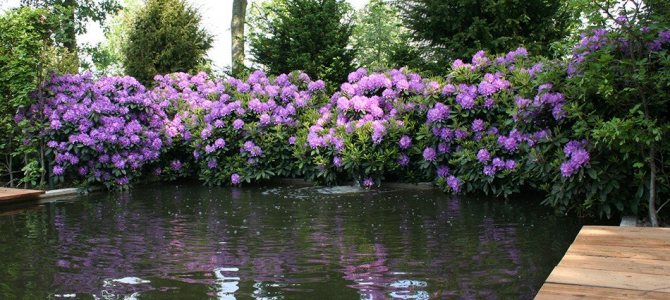

How to care for an azalea in the garden?
Spring
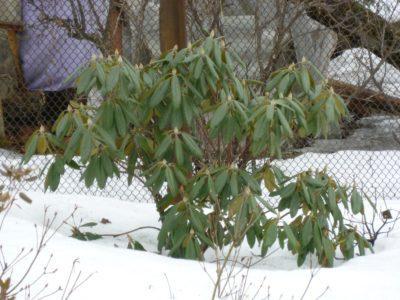

Evergreen azaleas require special attention during this period. The death of these plants is usually attributed to poor winter care and freezing. The real reason for the loss of these shrubs is that the bright April sun hits the azalea and causes moisture to evaporate through the leaves.
The ground has not yet thawed, the roots are not able to replace the loss of liquid and the plant dries up. It is necessary to stimulate the melting of snow around the rhododendron
, to accelerate the heating of the soil. As soon as the snow has melted and the temperature has reached +8 -10 degrees, you can feed the plants. Azalea blooms very early.
If you pick up varieties with different budding times, then these shrubs will decorate the garden from May to mid-July. To make the flowering of the next year more abundant, carefully pluck out the seed pods without damaging the young shoots.
Summer
The main task is to provide plants with comfortable moisture.
... After flowering, apply fertilizer under the rhododendrons.
Important!
This must be done no later than mid-July, so that the wood ripens well by winter.
Autumn period
In late autumn, we cover evergreen azaleas with a double layer of spandbond. The frame for the shelter can be metal arches, branches or a lattice box.
We do not use the covering film!
The purpose of this is not protection from frost, but so that in the spring the rhododendron does not get sunburn and does not die from the April drought. The deciduous varieties of these plants hibernate well without protection.
How to feed?
In the first season after planting, azaleas are not fed. In subsequent years, before and after flowering, apply, according to the instructions, any fertilizers intended for heather plants. It is difficult to prepare a fertilizer mixture on your own. Correcting mistakes In case of improper care or the action of negative weather conditions, you may encounter the following situations:
- After flowering, there is no growth of young shoots at the ends of the branches
... Adjust watering and fertilize. - When inspecting the plant, a bud affected by rot was found
... Cut it off along with some of the wood, otherwise it can dry out the entire branch. - Evergreen rhododendron emerged from winter with crumbling brown leaves
... Do not prune or uproot the plant! You can learn more about pruning a plant. In order for new branches to go from the axils of the leaves:- water the plant with the addition of any drug for the growth of new roots;
- spray bare twigs with zircon;
- only after the leaves appear, feed with fertilizer.
Be sure to plant rhododendrons in your garden.
... Do not be afraid of failure, because caring for them is much easier than for roses. They are not damaged by pests and do not get sick, subject to proper agricultural practices. This is a very noble and grateful plant that will decorate your garden before all other plants.
Useful video
How to choose the right place for planting and care for the rhododendron can be seen in the video:
Rhododendrons are beautiful ornamental plants of the heather family. They are difficult to grow in our climate. Their homeland is subtropics, so they love warmth and do not winter well in a harsh climate.
Rhododendrons are sissies. In order for them to grow in the climate of the middle zone, it is necessary to follow the rules of agricultural technology and the subtleties of care. But rhododendrons are so fascinating that more and more gardeners are paying attention to them. Before purchasing planting material for a plant, learn about the nuances of growing.
Planting site
In order to grow rhododendrons in the Moscow region, planting and caring for them should be carried out taking into account all the nuances that are important for such exotic plants. Otherwise, the plant may simply wither away or not give a beautiful flowering. The most destructive factors for him can be considered an overabundance of the sun and strong winds. For this reason, for planting, they select protected places from the northeastern or northern side of the house or a fence that will cover the plants from direct sunlight. It is worth knowing that "sissies" suffer not only from the summer sun, but also from the spring rays. Rhododendron buds can be sunburned already at the end of February. Therefore, plants need special care. In early spring, the bush should be shaded from the west and south, but it is necessary to leave gaps for ventilation.
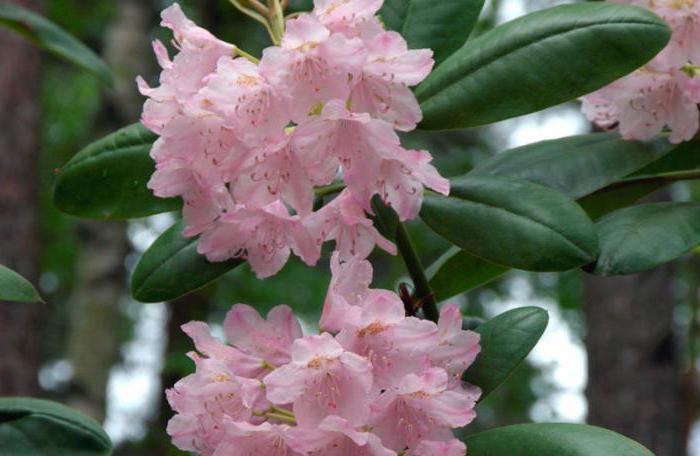

Plants can also be planted near trees, but it is worth remembering that they should not be adjacent to those that have a superficial root system. Exot can die in an unequal struggle for moisture and nutrition. Strongly not suitable as neighbors lindens, chestnuts, maples and birches, but oaks, pines and fruit trees have a good effect on rhododendrons. The best varieties for the Moscow region are very demanding on the place of growth.
Diseases and pests
Sunburn, overdrying or waterlogging of the soil, alkalization of the soil and other factors can lead to plant disease. Also rhododendrons can attack bedbugs, spider mites, weevils. Diazinon is effective from them. Flies, scale insects, mealybugs, and snails also attack bushes. They fight with karbofos.
Rhododendrons can be affected by rust, cancer and leaf spot. Such fungal diseases of these plants indicate poor aeration of the roots. To eliminate such lesions, copper sulfate and other drugs are used.
To rid the shrub of chlorosis, it is watered with water mixed with iron. The stems affected by cancer are removed, and the entire shrub is treated with Bordeaux liquid.
Varieties for central Russia
For planting in the Moscow region, you need to choose only frost-resistant varieties. Here is some of them.
- Rhododendron, further r. Ledebour;
- R. Katevbinsky and its hybrids;
- R. Smirnov and hybrids;
- R. Short-fruited;
- R. Largest;
- R. Golden;
- R. Canadian;
- R. Schlippenbach;
- R. Vaseya;
- R. Pukhansky;
- R. Adhesive;
- R. Pink.
Varieties for central Russia. Rhododendron pink
- As well as:
- R. "Costerianum";
- R. Japanese;
- R. Kamchatka;
- R. yellow;
- R. alpine (dwarf).
When can you open a rhododendron after winter?
It is necessary to remove the shelter from rhododendrons gradually in spring, especially from young bushes, so that it is easier for them to adapt to changing weather.
- After most of the snow has melted (mid-March - early April), the rosewood must be ventilated and then left with small ventilation slots on the sides.
- After thawing the soil 20-30 cm deep, in the evening or on a quiet cloudy day, you can open the rhododendron completely. Moscow region, Middle lane, Leningrad region - April 5-15. Ural, Siberia - April 15-25. Then it is advisable to shade the plant with spruce branches (leave it if it was).
- After removing the winter shelter from the evergreen "rose tree", the leaves, hanging and twisted, but with the beginning of the growing season, are leveled and straightened - it means that everything is in order with it and the wintering was successful.
Frozen leaves of an evergreen rhododendron after removing the winter shelter (At first, just cut them off, and after a month you can see if new ones will start to grow)
If you do not cover the flower for the winter, then so that it does not suffer from the spring sun, the buds do not dry out, and the flowering is not disturbed, it must be protected. To do this, shade the bush from the south and west in late February - early March.
- You can make a special shield or stretch fabric, covering material on the stakes. The height of the protective shelter must be made 1.5 times higher than the bush. In the case of strong winds, it is better to protect from them by making a small hut.
In the conditions of the Moscow Region, the Leningrad Region, the Middle Belt, the Urals and Siberia, the following species burn less in the spring: alpine (dwarf), Vaseya, Canadian, Ledebour, Pink and Sticky. And large-leaved evergreen species, Yellow, Schlippenbach and Japanese, do not tolerate the bright spring sun worse.

